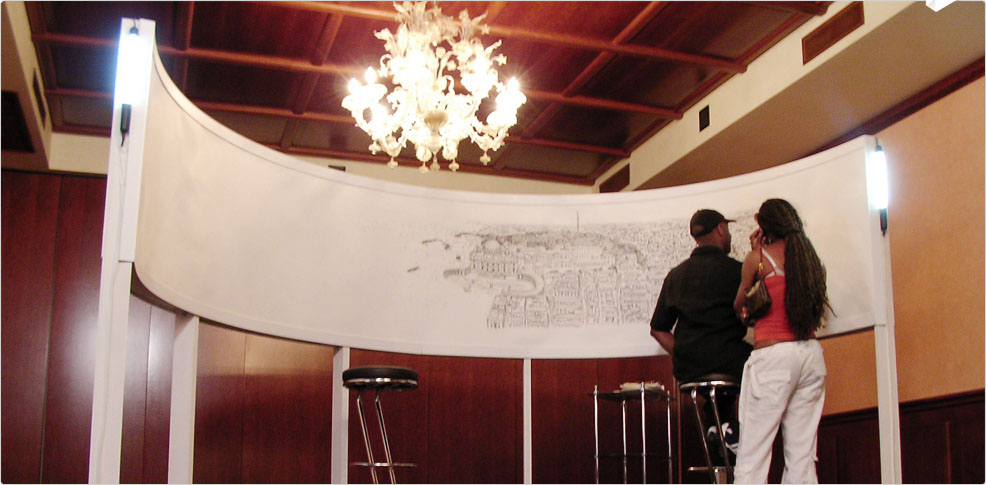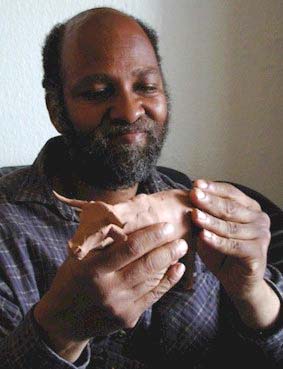I det foregånede indlæg tog jeg hul på et emne som jeg så vil prøve at forfølge videre i dette og - antagelig - senere indlæg: særlige evner.
Jeg blev specielt optaget af den vinkel på emnet, som filmen om den velfungerende Daniel Tammet gav indblik i, en mand i begyndelsen af 30´erne der både var asberger-autist, savant og synæstetiker - og samtidig så socialt og kommunikativt velfungerende at han verbalt kunne reflektere over sine særlige evner.
Min første erindring om emnet er ellers knyttet til filmen "Rain Man" med Dustin Hoffman i en hovedrolle som bestemt ikke var socialt velfungerende.
Rollen bygger på en virkelig savant Lawrence Kim Peek som Wikipedia fortæller om:
Peek was born in Salt Lake City with macrocephaly,[5] damage to the cerebellum, and agenesis of the corpus callosum,[7] a condition in which the bundle of nerves that connects the two hemispheres of the brain is missing; in Peek's case, secondary connectors such as the anterior commissure were also missing.[5] There is speculation that his neurons made unusual connections due to the absence of a corpus callosum, which resulted in an increased memory capacity.[8][9]
Lawrence Kim Peek var altså svært hjerneskadet, og faglitteraturen peger på at det gælder mange af de personer som har særlige evner - specielt når de gælder hukommelse.
Det ser ud til at der er specielt er tale om skader i venstrehjernehalvdels frontallapper, som så tilsyneladende frigør helt udsædvanlige hukommelsesresourcer knyttet til visuel perception i den højre hjernehalvdel.
Metaforisk anvendes betegnelsen "islands of genius" om det mentale set up hos disse personer idet rigtig mange af dem på mange andre områder har en lav eller i bedste fald normal IQ.
Hos mange viser disse evner sig tidligt i barndommen, fx ved at de af sig selv har lært at læse - ofte inden de kan tale rent. Således også Kim Peek:
According to Peek's father, Fran (Francis) Peek, Kim was able to memorize things from the age of 16–20 months. He read books, memorized them, and then placed them upside down on the shelf to show that he had finished reading them, a practice he maintained all his life. He could speed through a book in about an hour and remember almost everything he had read, memorizing vast amounts of information in subjects ranging from history and literature, geography and numbers to sports, music and dates. He could read quite quickly, scanning the left page with his left eye, then the right page with his right eye. According to an article in The Times newspaper, he could accurately recall the contents of at least 12,000 books.[6] Peek lived inMurray, Utah and spent a considerable amount of his time reading at the Salt Lake City Library and demonstrating his capabilities at schools, with great help from his father.[10]
En anden internationale berømt savant er Stephen Wiltshire. Han kan tegne hvad han har set i kort tid - med noget der nærmer sig fotografisk nøjagtighed i både perspektiv og detaljer, som fx det her panorama som han har tegnet på tre dage efter tre kvarters helikoptertur over byen Rom:

Her er hvad Wikipedia kan fortælle om hans barndom og uddannelse:
Wiltshire was born in London, England, in 1974 to West Indian parents. Wiltshire was mute when young. At the age of three, he was diagnosed as autistic. The same year, his father died in a motorbike accident.At the age of five, Stephen was sent to Queenwmill School in London where he expressed interest in drawing. He began to communicate through his art. His teachers encouraged his drawing, and with their aid Wiltshire learned to speak at the age of five.At the age of eight, he started drawing imaginary post-earthquake cityscapes and cars.When he was ten, Wiltshire drew a sequence of drawings of London landmarks, one for each letter, that he called a "London Alphabet".In 1987, Wiltshire was part of the BBC programme The Foolish Wise Ones.Drawings, a collection of his works, was published that same year.Between 1995 and his graduation in 1998, Wiltshire attended the City and Guilds of London Art School in Kennington, Lambeth, South London.
I 2006 blev Wiltshire tildelt "the Order of the Britishc Empire" (MBE) for sine bidrag til kunsten. Samme år åbnede han et permanent galleri i the Roayl Opera Arcade i London.
Det kendetegner mange savanter at de har store problemer med at udtrykke sig verbalt, hvilket stemmer godt overens med at det er venstre side af hjernen hvor sprogcenterne sidder, der på en eller anden måde er funktionelt skadet, samtidig med at højre hjernehalvdel bliver "frigjort" til formål og lokale neurologisk processer som ellers holdes tilbage eller begrænses af hjernens overordnede og koordinerende styrestem i frontallapperne.
Ligesom ved synæstesi som jeg tidligere har beskrevet, kan en delforklaring altså være at den overordnede 'latente hæmning' som udspringer at det neurologisk "styresystem" i frontallappen - den såkaldt 'eksekutive' del af hjernen, kan være svækket sådan at visuel eller auditiv hypersensitivitet og den visuelle hukommelse får mulighed for at køre i et meget højre "gear" - og tilsyneladende fungerer i en slags turboagtig "overdrive".
Local processing may normally be actively inhibited. This idea has been referred to as the tyranny of the frontal lobes (especially of the left hemisphere), which impart top-down expectations with such authority that they override lower areas, conscripting them into service for the greater good. The potential of the local elements to process detailed information is thus superseded in order to achieve optimal global performance. The idea that local processing is actively suppressed is supported by the fact that savant abilities can sometimes emerge after frontal lobe injuries or in cases of frontotemporal dementia. Increased skills in numerical estimation can also, apparently, be induced in healthy people by using transcranial magnetic stimulation to temporarily inactivate part of the left hemisphere.http://www.wiringthebrain.com/2011/06/synaesthesia-and-savantism.html
Traditionelt forbinder man ikke autister med kreativitet, nærmest det modsatte. Nogle af de kendetegn som fremhæves i litteraturen om autister, er deres ønske om trygge omgivelser med klare grænser, problemer med at sætte sig i andres sted, og vanskeligheder ved at forstå sprog i overført betydning som metaforer og ironi.
Ikke desto mindre er der altså en række af disse 'supersavanter' som netop har særlige mimetiske evner - som altså Stephen Wiltshire.
Et andet eksempel er Alonzo Clemons som har et kæmpetalent hvad angår at modellerer ekstremt vellignende og livagtige dyrefigurer - og han gør det næsten tvangsmæssigt og på næsten ingen tid:

Han er en af de personer hvis særlige evner opstod som en konsekvens af en påført hjerneskade.
Wikipedia:
Alonzo Clemons is an American animal sculptor and a savant. He lives in Boulder, Colorado.Clemons suffered a severe brain injury as a child that left him developmental disabeld (with an IQ in the 40-50 range), but able to create very accurate animal sculptures out of clay. Clemons can create a sculpture of almost any animal, even if he has seen only a glimpse of it. He is also able to create a realistic and anatomically accurate three-dimensional rendering of an animal after only looking at a two-dimensional image for mere moments. He is most well known for his life-size renderings of a horse, but most of his works are smaller, and accomplished in less than an hour.In 1986 he had a premiere exhibit in Aspen, Colorado. His works have sold for as much as $45,000.
Her er fotos af nogle af Clemons ekstremt livagtige skulpturer - støbt i bronze:



Jeg får en mistanke om at den stenaldermand der for godt 14.000 år siden malede denne figur på en klippevæg i en hule i Frankrig, også har været en savant:

En hjemmeside der formidler kunstsalg, og altså også nogle af Alonzo Clemons dyreskulpturer, fortæller blandt andet at han og hans omgivelser blev bevidst om hans specielle kunstneriske kvalifikationer, da filmen "Rain Man" skabte medieopmærksomhed omkring savanters særlige evner:
As a toddler, Clemons suffered a head injury in an accident; this changed the way he thinks, learns and communicates. While much was lost due to the injury, something miraculous also occurred, for as Clemons sometimes puts it, "God gave a gift."He began showing a fascination with modeling materials and a tremendous inner drive to make sculpture. Even in situations where he did not have access to modeling clay, his determination to make models of animals was so great that he found materials in his environment that he could use for sculpting.For over twenty years he continued to practice his art in obscurity until the early 1980's, when the movie Rain Man, which featured Dustin Hoffman in the role of a disabled man with remarkable skills of memory, brought international media attention to a phenomenon known as the Savant Syndrome.Savant Syndrome is a descriptive term applied to individuals who have both a developmental disability and a spectacular, genius-level skill in a specific area. Clemons is recognized as one of the world's prodigious savants and has been featured on programs such as 60 Minutes, Geraldo, and the Discovery Channel's World of Wonder.This media exposure gave him the opportunity to gain worldwide recognition for his art. From his youth, Clemons had not only the genius for his art, but has shown an inner vision to become successful with it, and those dreams are truly continuing to unfold in his life.
Jeg kan ikke lade være med at associere til kunstprofessoren Betty Edwards hvis instruktive bøger handler om kunsten at se og tegne det man ser uden interferens fra ens kategoriske forforståelse af det man tegner.
Det mentale 'trick' som hun fremhæver hvis man skal lære at tegne så det ligner, er netop at lære at lukke ned for venstre hjernehalvdels mentale processer i forhold til det tegnede objekt, og at lukke helt op for højre hjernehalvdels direkte perception og måde at bearbejde sanseindtryk på:
Hvad ved man i øvrigt generelt om 'savant-syndromet'? - som altså er den videnskabelige betegnelse for mennesker der tydeligvis er mentalt handicappede og udviklingsforstyrrede på en række områder, men til gengælde på specielle snævre felter er udstyret med helt ekstraordinære evner.
- Ca. 1 ud af 1000 mentalt retarderede personer har 'savant-evner'. Og Seks gange flere mænd end kvinder har syndromet.
- Savant-evnerne kan være noget der er medfødt eller det kan være erhvervet senere i livet efter hjerneskader, specielt skader i venstre hjernehalvdel. Og disse specielle evner findes hos ca. 10 procent af alle autistiske personer.
- De fleste savanter har en intelligenskvotient (IQ) på under 70, men der findes også savanter med normal eller høj IQ. Daniel Tammet som jeg skrev om i det foregående indlæg, rapporterer selv at have en IQ på 150.
- De særlige savant-evner viser sig især inden for følgende områder: musik, kunst, matematik og kalenderberegning.
- Men savanter har også haft særlige evner inden for fremmedsprogsbeherskelse, ekstremt tidlig læsefærdighed, færdighed i at orientere sig rumligt og finde vej, ekstremt naturtro modelbyggeri.
- Savanter har i langt de fleste tilfælde en ekstremt god hukommelse, ofte det der kaldes 'eidetic memory' eller fotografisk hukommelse.
- Under 50 personer i verden er såkaldte vidunder-savanter, som fx Stephen Wiltshire og Daniel Tammet.
Her er et link til en videnskabelig artikel der gennemgår "hvad man ved" og de teorier man har om disse særlige menneskers hjerne og evner.
http://www.ncbi.nlm.nih.gov/pmc/articles/PMC2677584/
Her som andre steder understreger man at udforskningen af disse mirakuløst talentfulde hjerner inden for ekstremt snævre kompetencer, giver muligheder for indsigt også i hvad normale (menneskers) hjerner i princippet kan yde under særlige vilkår eller ved særlige træningsprogrammer.
En sidste savant-case som jeg vil fremhæve, er Jason Padgett, som var udsat for et alvorligt overfald der førte til en hjerneskade. Efter overfaldet udviklede han en form for synæstesi som kom til udtryk ved at han ikke kunne lade være med at se såkaldte 'fraktaler' overalt når han iagttog sin omverden - og derefter at kunne tegne hvad han så.
Sådan beskrevet i en artikel fra Huffington Post den 21 juli 2011:
The 41-year-old does not see the world in the same way that most people do.Everywhere he looks, he sees complex mathematical formulas -- like the Pythagorean theorem, for example. “Every single little curve, every single spiral, every tree is part of that equation,” he told ABC News.Padgett turns these formulas into intricate diagrams called fractals. He says that fractals are "shape(s) that when you take the shape a part into pieces, the pieces are the same or similar to the whole."For instance, he can produce a visual representation of Pi, the infinite mathematical constant which begins with 3.14.According to the Daily Mail, Padgett is the only person in the world known to have this skill.Incredibly, Padgett has no advanced math degree: He is a college dropout who currently works at a futon store. According to Q13 Fox News, prior to the mugging, he couldn't even draw.Neuroscientist and philosophy professor Berit Brogaard, who has run a series of tests on Padgett, told ABC News that his genius was likely obtained by sheer accident when he was brutally beaten by muggers. During the tests, two specific areas of his brain lit up -- the area that controls math and mental imagery,Q13 Fox News reports.
Brogaard explained that damage caused by the attack has forced Padgett's brain to overcompensate in certain areas that most people don’t have access to, transforming him into an "acquired savant."
This is a time lapse film of Jason Padgett hand drawing a Quantum Star fractal. Jason has mathematical synesthesia due to a brain injury he received in 2002. As a result of that injury, he now sees numbers as shapes. this condtion is called Acquired Savant Syndrome. He is the only know Savant with Mathematical Synaesthesia who does not have Autism or Asperger's Syndrome. He is currently being trained in traditional mathematics and is able to describe what he is seeing, in geometric form (drawings) and now also in equation. It is our hope that as he advances through school he will be able to describe in equation what he and those with synaesthesia see and how it works.
Nedenfor følger en oversigt over kendte savanter.
Bemærk at mange af de musikalske savanter er blinde. Det understreger det jeg har skrevet om tidligere, med afsæt i Oliver Sachs, Daniel Goleman og Sharon Begleys bøger, at hjernen er "plastisk" sådan at svagheder og mangler i nogle dele af hjernen eller sanseapparatet kan indebærer at hjernen reorganiserer sine neurale forbindelser og netværk som en slag kompensation.